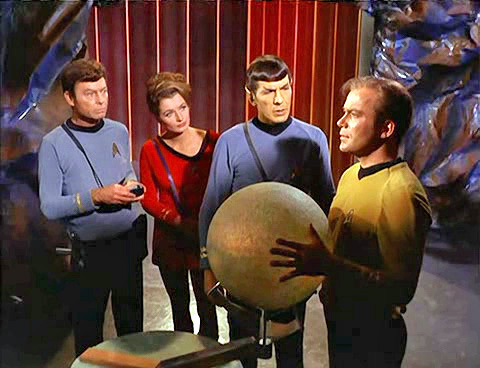The first show I watched was Star Trek. In the episode, “Return to Tomorrow”, the crew of the Enterprise encounter a planet that was decimated by a cataclysmic event. Eminating from the planet’s center (an example of extended-cognition) is a voice called Sargon who asks Captain Kirk, accompanied by Spock, McCoy, and Dr. Mulhall, to beam down to the planet. When they beam down, the crew finds Sargon speaking through an orb asking Kirk to allow him to take control of his body. Through Emboddied Cognition, Kirk touches Sargon’s orb and Sargon transfers his consciousness into Kirk’s body.

Through Kirk’s voice, it seems that Sargon feels immense freedom after being “trapped” in his orb for half a million years. He goes on to explain that Kirk’s mind has an insuffcient amount of energy for him to speak freely while Sargon is in control and his energy is too powerful for Kirk’s body to handle which, according to McCoy and Dr. Mulhall, will result in Kirk’s death. In this episode, I feel as if Sargon has an appreciation for Kirk’s well-being in that he factors in the emboddied relationship between mind and body–this being the health and safety of Kirks body as it effected by Sargon’s mind.

The next show I watched was Altered Carbon with the episode titled “Out of the Past”. 250 years after being shot and killed, Takeshi Kovacs wakes up in an entirely new body called “a sleeve”. While doctors prep Kovacs’ new body, a voice over states: “Your body is not who you are. You shed it like a snake sheds its skin. Leave it, forgotten, behind you.” This quote is a direct contrast to the basis of Embodied Cognition which says “a body is not something you have, but something you are.”

Compared to “Return to Tomorrow”, the relationship between the mind and the body “Out of the Past” is vastly contrasted. In this episode, the body is seen as disposable whereas the mind is seen as something that can essentialy transcend permanent death by being placed into new bodies. It seems the mind is the only constant in this relationship.
The last show I watched was Futurama with the episode titled “The Day the Earth Stood Stupid”. This episode, unlike Star Trek and Altered Carbon, is an example of the concept of the “Brain in a Vat”.

In one particular scene from the episode, the Big Brain, who is a member of a collective brain conciousness trying to wipe out all thoughts in the universe, transports Fry and Leela to “a mental realm” which lies in each book. In this scenario, the Big Brain would be the mad scientist and the act of him transporting Fry and Leela to different mental realms is an example of the creation of virutal stimuli that is being fed directly to their brains. As the Brain in a Vat concept states, the brain would register all these stimuli in exactly the same manner as normal human experiences. We see this as Fry and Leela can interact different objects and environments within each realm.
One thought on “Analysis #1 — The Relationship Between the Mind and the Body”
Hi Paul,
I love that you are thinking about Sargon’s ability to project his thoughts into other people’s minds as a form of extended cognition. Though that is not exactly what theorists are talking about when they describe the mind as extended, it does offer an interesting literalizing the way that we think with and through our interactions with the environment and those around us. Your description of the “collective brain consciousness” also has me thinking about how we might frame this in terms of extended cognition.
You do a really nice job of connecting the brain in the vat to the Futurama episode we watched. The idea of a “mental realm” that aligns with the neural stimulation that the brain in the vat proposes. It raises important questions about perception and the role that our bodies play in how we interact with the world.
Jessica Hautsch